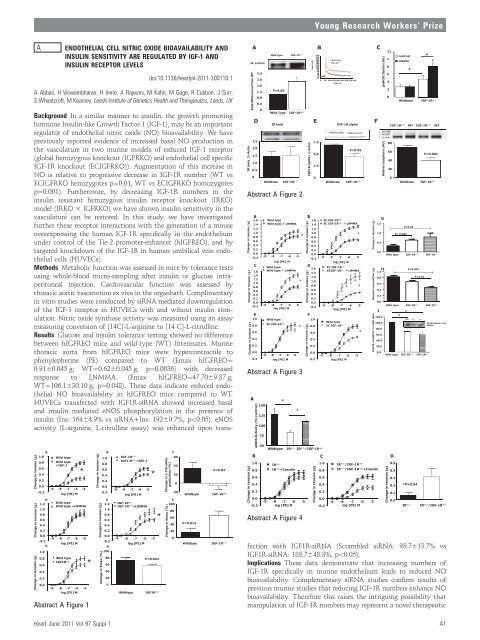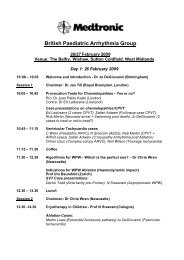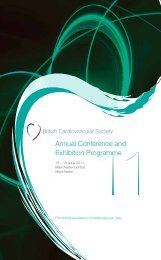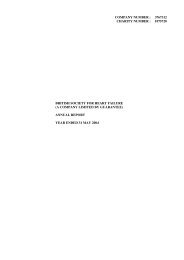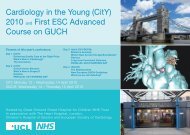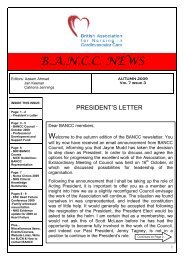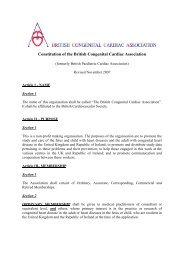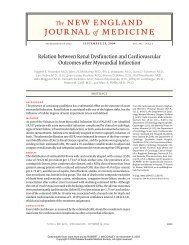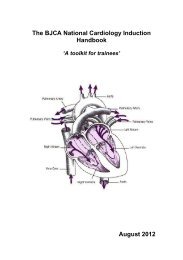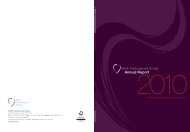Full Supplement - British Cardiovascular Society
Full Supplement - British Cardiovascular Society
Full Supplement - British Cardiovascular Society
You also want an ePaper? Increase the reach of your titles
YUMPU automatically turns print PDFs into web optimized ePapers that Google loves.
Young Research Workers’ Prize<br />
A<br />
ENDOTHELIAL CELL NITRIC OXIDE BIOAVAILABILITY AND<br />
INSULIN SENSITIVITY ARE REGULATED BY IGF-1 AND<br />
INSULIN RECEPTOR LEVELS<br />
doi:10.1136/heartjnl-2011-300110.1<br />
A Abbas, H Viswambharan, H Imrie, A Rajwani, M Kahn, M Gage, R Cubbon, J Surr,<br />
S Wheatcroft, M Kearney. Leeds Institute of Genetics Health and Therapeutics, Leeds, UK<br />
Abstract A Figure 2<br />
Abstract A Figure 3<br />
Abstract A Figure 4<br />
Abstract A Figure 1<br />
Heart June 2011 Vol 97 Suppl 1<br />
Background In a similar manner to insulin, the growth promoting<br />
hormone Insulin-like Growth Factor-1 (IGF-1), may be an important<br />
regulator of endothelial nitric oxide (NO) bioavailability. We have<br />
previously reported evidence of increased basal NO production in<br />
the vasculature in two murine models of reduced IGF-1 receptor<br />
(global hemizygous knockout (IGFRKO) and endothelial cell specific<br />
IGF-1R knockout (ECIGFRKO)). Augmentation of this increase in<br />
NO is relative to progressive decrease in IGF-1R number (WT vs<br />
ECIGFRKO hemizygotes p¼0.01, WT vs ECIGFRKO homozygotes<br />
p¼0.001). Furthermore, by decreasing IGF-1R numbers in the<br />
insulin resistant hemizygous insulin receptor knockout (IRKO)<br />
model (IRKO 3 IGFRKO) we have shown insulin sensitivity in the<br />
vasculature can be restored. In this study, we have investigated<br />
further these receptor interactions with the generation of a mouse<br />
overexpressing the human IGF-1R specifically in the endothelium<br />
under control of the Tie-2 promoter-enhancer (hIGFREO), and by<br />
targeted knockdown of the IGF-1R in human umbilical vein endothelial<br />
cells (HUVECs).<br />
Methods Metabolic function was assessed in mice by tolerance tests<br />
using whole-blood micro-sampling after insulin or glucose intraperitoneal<br />
injection. <strong>Cardiovascular</strong> function was assessed by<br />
thoracic aortic vasomotion ex vivo in the organbath. Complimentary<br />
in vitro studies were conducted by siRNA mediated downregulation<br />
of the IGF-1 receptor in HUVECs with and wihout insulin stimulation.<br />
Nitric oxide synthase activity was measured using an assay<br />
measuring conversion of [14C]-L-arginine to [14 C]-L-citrulline.<br />
Results Glucose and insulin tolerance testing showed no difference<br />
between hIGFREO mice and wild-type (WT) littermates. Murine<br />
thoracic aorta from hIGFREO mice were hypercontractile to<br />
phenylepherine (PE) compared to WT (Emax hIGFREO¼<br />
0.9160.045 g; WT¼0.6260.045 g, p¼0.0036) with decreased<br />
response to LNMMA (Emax hIGFREO¼47.7069.87 g;<br />
WT¼106.1630.10 g, p¼0.048). These data indicate reduced endothelial<br />
NO bioavailability in hIGFREO mice compared to WT.<br />
HUVECs transfected with IGF1R-siRNA showed increased basal<br />
and insulin mediated eNOS phosphorylation in the presence of<br />
insulin (Ins: 16464.9% vs siRNA+Ins: 19260.7%, p


